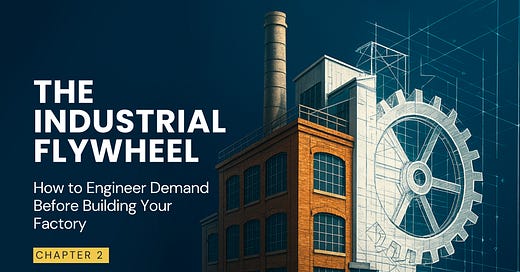The Industrial Flywheel: How to Engineer Demand Before Building Your Factory | Chapter 2
What if your factory could sell before it exists?
Welcome back to The Industrial Flywheel, Chapter 2. If you missed Chapter 1, you can check it out here.
In Chapter 1, we explored the concept of “engineering demand” in the deep-tech and industrial innovation world, emphasizing how early commercial signals, partnerships, and structured commitments can de-risk the journey toward building factories. We introduced the idea that meaningful engagement with potential customers and stakeholders should begin long before you pour concrete for your production line.
But how do you turn those early conversations into concrete data and commitments that propel you from lab prototype to a true industrial operation?
The answer often lies in the pilot project—the crucible where you take your lab-validated concept and test it under real-world conditions, bridging the gap between “it works in the lab” and “we can justify building capacity at scale.”
Below, we’ll delve into every aspect of designing, financing, and executing an industrial or deep-tech pilot in a way that not only proves your technology but also generates tangible market traction. We’ll start with the fundamentals of why pilot projects matter, how to select the right partners, and how to structure the pilot with an eye on the final commercial goal. Then we’ll transition into more advanced insights—such as the Adoption Readiness Level (ARL) framework, bridging the dreaded gap between a successful pilot and real market uptake, and eventually moving from pilot lines or microfactories to full-on manufacturing.
Just as in software, where a successful MVP is the stepping stone to scale, in deep tech, the pilot can be the pivot point that converts potential into actual demand.
Done right, this approach can accelerate your journey to production, lock in anchor customers with contractual commitments, and solidify your industrial flywheel—where each successful pilot iteration boosts investor confidence, sharpens market interest, and paves the way for commercial success.
Let’s dive in.
✨ This Insight is reserved for Premium Members.
By joining The Scenarionist Premium, you’ll unlock full access to this Insight, along with our in-depth Venture Guide Series—a collection of strategic frameworks and case-based insights designed to help you build and back exceptional deep tech companies, and The Deep Tech Negotiation Playbook Series, where we unpack the tactics, levers, and deal dynamics that define successful founder–investor negotiations in complex, science-driven ventures.
1. Pilot Projects: The Crucible of Demand and Product Fit
I’ll never forget visiting a small robotics startup, fresh out of a top-tier engineering program. Their lab prototype was captivating—an autonomous manipulator that looked like it could go head-to-head with solutions from much larger, well-established companies. Investors were buzzing, convinced this tech had the potential to transform robotic assembly lines.
But when I asked the founders how they planned to test it in a real factory—where dust, downtime, unpredictable shift changes, and complex throughput could throw everything off—they just stared at me, unsure how to respond.
Not long after, a senior partner at a VC firm gave them a dose of reality: “Show us it can run continuously in an actual production environment, and then we’ll talk about a serious round.” That was their wake-up call—a slick lab demo wasn’t going to cut it.
And that’s exactly the purpose of a pilot project: to take your invention out of the clean, controlled lab and drop it into the messy, unpredictable world of real manufacturing workflows.
1.1 The Role of the Pilot Project
A pilot project is the proving ground where a deep tech concept transitions from “this works in the lab” to “this has commercial viability.”
This stage often uncovers hidden pitfalls:
Performance Gaps: Technologies that shine in the lab don’t always scale linearly. A pilot often exposes performance bottlenecks—whether in production throughput, material durability, or process efficiency.
Reliability Concerns: Running a prototype continuously for weeks or months reveals reliability flaws that would never surface in a short bench test. This is exactly why major industrial buyers or corporate investors want to see extended runtime data before trusting your solution at scale.
Economic Feasibility: Even if the core physics or chemistry holds up, industrial partners need to evaluate cost structures, potential ROI, and how easily the technology can integrate into existing workflows without causing major disruptions or budget overruns.
Investor Confidence: Finally, a pilot backed by tangible metrics and enthusiastic partner feedback becomes rocket fuel for fundraising. One investor friend of mine calls it “the difference between a dazzling pitch deck and a real business.”
Think of the pilot as your minimum viable factory—just on a smaller scale.
If it succeeds, it helps bridge the critical “credibility gap” that often holds back hardware and industrial startups: you’re no longer just an impressive lab experiment—you’re a tested, validated player in the market.





